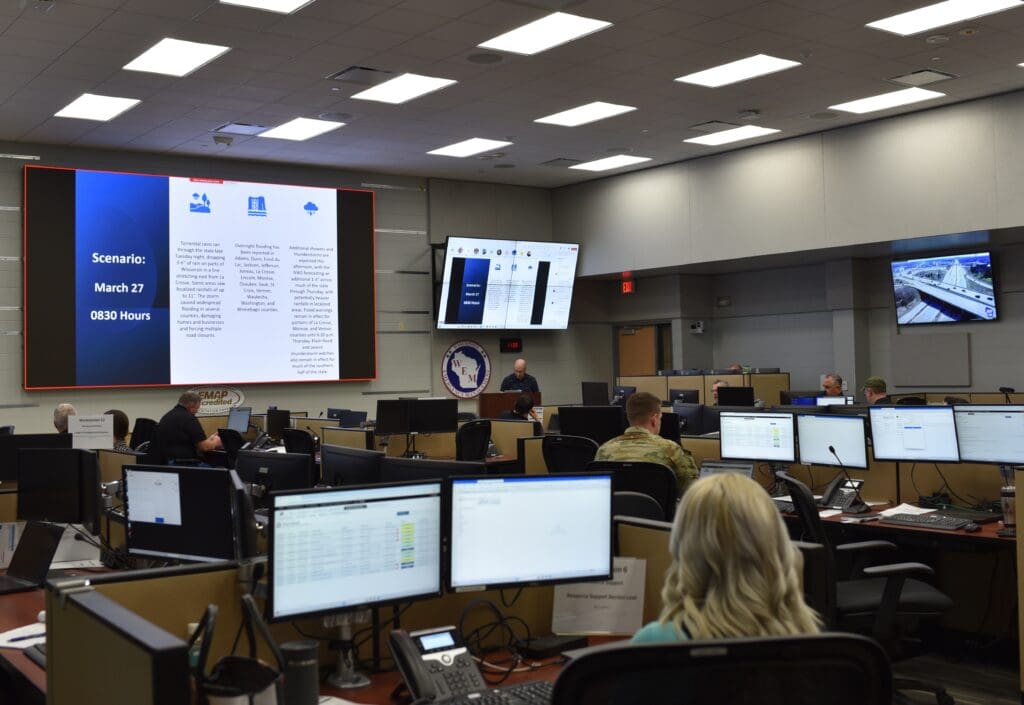
During a major disaster, Wisconsin’s State Emergency Operations Center (SEOC) in Madison serves as a central location for state agencies to coordinate their efforts. The work done in the SEOC directly supports the county, tribal, and municipal Emergency Operations Centers (EOC) that are often already operating in affected areas.
“The SEOC is the primary point of contact for local emergency management to request assistance when the needs of an incident exceed what is available locally,” said Wisconsin Emergency Management (WEM) Administrator Greg Engle. “It’s one of the most critical tools we have for ensuring resources are being directed where they are needed most and for building awareness about the impacts of a disaster.”
For years, Wisconsin’s SEOC has responded to incidents such as flooding, wildfires and tornadoes using an Incident Command System (ICS) structure, which was designed to create a standardized approach to managing an incident response. ICS has also traditionally been the most widely adopted standard used in most EOCs, but in recent years emergency managers have begun to recognize that EOCs serve a different purpose than incident command and should be organized to better fit their unique role.
“The ICS structure was intended for incident response, but the SEOC provides support to local incident responses through the coordination of resources,” said WEM Bureau of Planning and Preparedness Director Ruhamah Bauman. “Using ICS often resulted in the assigned roles of the SEOC crossing over to areas that didn’t really fit under their traditional descriptions, which sometimes caused confusion between roles and responsibilities.”
To address these differences, WEM started exploring alternative models of operation through research, meeting with other ISM states and collecting feedback from SEOC staff. After extensive planning and a reorganization of SEOC positions, the division transitioned to a new structure on April 1, known as an Incident Support Model (ISM).
“The ISM structure allows the SEOC to focus on resource request coordination and developing situational awareness during an incident,” said Elizabeth Dahl, an operations and resource management planner with WEM who helped lead planning for the transition to ISM. “This allows the EOC to take on more of a coordination role, rather than an operations and tactics-focused role. It means we can better support our counties and tribes during emergencies.”
A key feature of ISM is a more refined process for gathering information from different response areas to provide better situational awareness about the response to an incident. While that information was available under the Incident Command System, the ISM structure designates a section dedicated specifically to the task. During an activation, staff process resource request calls from local emergency management and state agency partners, collect information from the many agencies who may be responding to an incident, and create regular situation reports that help partners make informed decisions.
“I think there is a lot of merit to putting more resources into situational awareness development and products that maximize our tools to capture what happened, what is happening, and what is most likely to happen during operations,” said Eric Franco, who supports the SEOC in the planning section.
The ISM also creates a resource support section designed to consolidate and streamline the process of making sure critical needs can be fulfilled as quickly as possible.
“Previously, if an agency was requesting a resource it would snake through a few folks in the SEOC before we actually got to the resource provider,” said Brent Krebs, who served in operations under the ICS structure and now serves as a situational awareness section chief under the ISM. “We’re cutting out some unnecessary steps so SEOC staff will be able to start working on a request immediately. When it used to be done by folks in a few different sections, the process could slow requests down along the way.”
In the lead-up to the transition, WEM staff participated in training and exercises that operated under the ISM structure. It will also be used later this spring, when the SEOC hosts the annual drill and exercise for the Radiological Emergency Preparedness program.
The SEOC also activated in early April under the ISM structure after a storm system produced heavy snow in the state. The storm caused dangerous road conditions and resulted in power outages in east central and northeastern Wisconsin that affected over 100,000 customers. WEM staff were able to monitor conditions and work with partners as they carried out their responses to the storm.
“The ISM structure has already been put to the test in guiding the state’s response to an incident where our county, tribal and utility partners were working to respond to conditions in their areas,” Engle said. “Using it this month, we demonstrated the SEOC is ready and able to continue supporting incidents throughout the state.”
Wisconsin Emergency Management is a division of the Wisconsin Department of Military Affairs. You can find more information about WEM and its mission at https://wem.wi.gov/.

